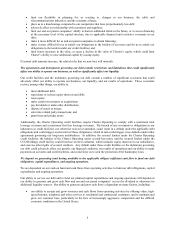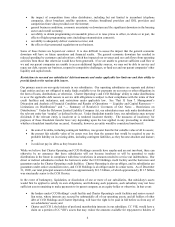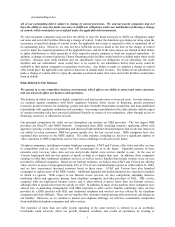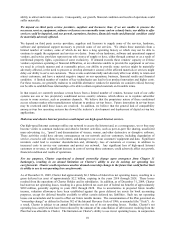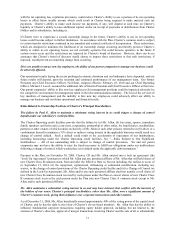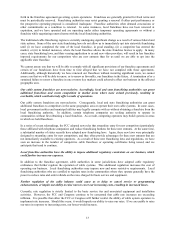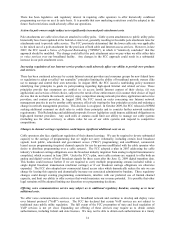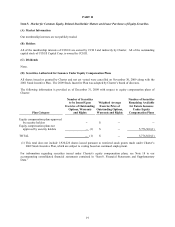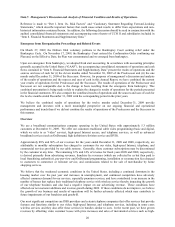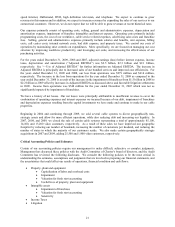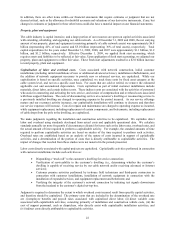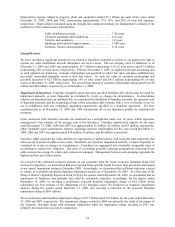Charter 2009 Annual Report Download - page 18
Download and view the complete annual report
Please find page 18 of the 2009 Charter annual report below. You can navigate through the pages in the report by either clicking on the pages listed below, or by using the keyword search tool below to find specific information within the annual report.
15
manner, or conditions could be imposed upon such licenses or authorizations that may not be favorable to us. The
FCC has extended certain traditional telecommunications requirements, such as E911, Universal Service fund
collection, CALEA, Customer Proprietary Network Information and telephone relay requirements to many VoIP
providers such as us. Telecommunications companies generally are subject to other significant regulation which
could also be extended to VoIP providers. If additional telecommunications regulations are applied to our VoIP
service, it could cause us to incur additional costs.
Item 2. Properties.
Our principal physical assets consist of cable distribution plant and equipment, including signal receiving, encoding
and decoding devices, headend reception facilities, distribution systems, and customer premise equipment for each
of our cable systems.
Our cable plant and related equipment are generally attached to utility poles under pole rental agreements with local
public utilities and telephone companies, and in certain locations are buried in underground ducts or trenches. We
own or lease real property for signal reception sites, and own most of our service vehicles.
Our subsidiaries generally lease space for business offices throughout our operating divisions. Our headend and
tower locations are located on owned or leased parcels of land, and we generally own the towers on which our
equipment is located. Charter Holdco owns the land and building for our principal executive office.
The physical components of our cable systems require maintenance as well as periodic upgrades to support the new
services and products we introduce. We believe that our properties are generally in good operating condition and
are suitable for our business operations.
Item 3. Legal Proceedings.
Patent Litigation
Ronald A. Katz Technology Licensing, L.P. v. Charter Communications, Inc. et. al. On September 5, 2006, Ronald
A. Katz Technology Licensing, L.P. served a lawsuit on Charter and a group of other companies in the U. S. District
Court for the District of Delaware alleging that Charter and the other defendants have infringed its interactive
telephone patents. Charter denied the allegations raised in the complaint. On March 20, 2007, the Judicial Panel on
Multi-District Litigation transferred this case, along with 24 others, to the U.S. District Court for the Central District
of California for coordinated and consolidated pretrial proceedings. Charter is vigorously contesting this matter.
Rembrandt Patent Litigation. On June 6, 2006, Rembrandt Technologies, LP sued Charter and several other cable
companies in the U.S. District Court for the Eastern District of Texas, alleging that each defendant's high-speed data
service infringes three patents owned by Rembrandt and that Charter's receipt and retransmission of ATSC digital
terrestrial broadcast signals infringes a fourth patent owned by Rembrandt (Rembrandt I). On November 30, 2006,
Rembrandt Technologies, LP again filed suit against Charter and another cable company in the U.S. District Court
for the Eastern District of Texas, alleging patent infringement of an additional five patents allegedly related to high-
speed Internet over cable (Rembrandt II). Charter has denied all of Rembrandt’ s allegations. On June 18, 2007, the
Rembrandt I and Rembrandt II cases were combined in a multi-district litigation proceeding in the U.S. District
Court for the District of Delaware. On November 21, 2007, certain vendors of the equipment that is the subject of
Rembrandt I and Rembrandt II cases filed an action against Rembrandt in U.S. District Court for the District of
Delaware seeking a declaration of non-infringement and invalidity on all but one of the patents at issue in those
cases. On January 16, 2008 Rembrandt filed an answer in that case and a third party counterclaim against Charter
and the other MSOs for infringement of all but one of the patents already at issue in Rembrandt I and Rembrandt II
cases. On February 7, 2008, Charter filed an answer to Rembrandt’ s counterclaims and added a counter-
counterclaim against Rembrandt for a declaration of non-infringement on the remaining patent. On October 28,
2009, Rembrandt filed a Supplemental Covenant Not to Sue promising not to sue Charter and the other defendants
on eight of the contested patents. One patent remains in litigation, and Charter is vigorously contesting Rembrandt's
claims regarding it.
Verizon Patent Litigation. On February 5, 2008, four Verizon entities sued Charter and two other Charter
subsidiaries in the U.S. District Court for the Eastern District of Texas, alleging that the provision of telephone
service by Charter infringes eight patents owned by the Verizon entities (Verizon I). On December 31, 2008, forty-
four Charter entities filed a complaint in the U.S. District Court for the Eastern District of Virginia alleging that
Verizon and two of its subsidiaries infringe four patents related to television transmission technology (Verizon II).


